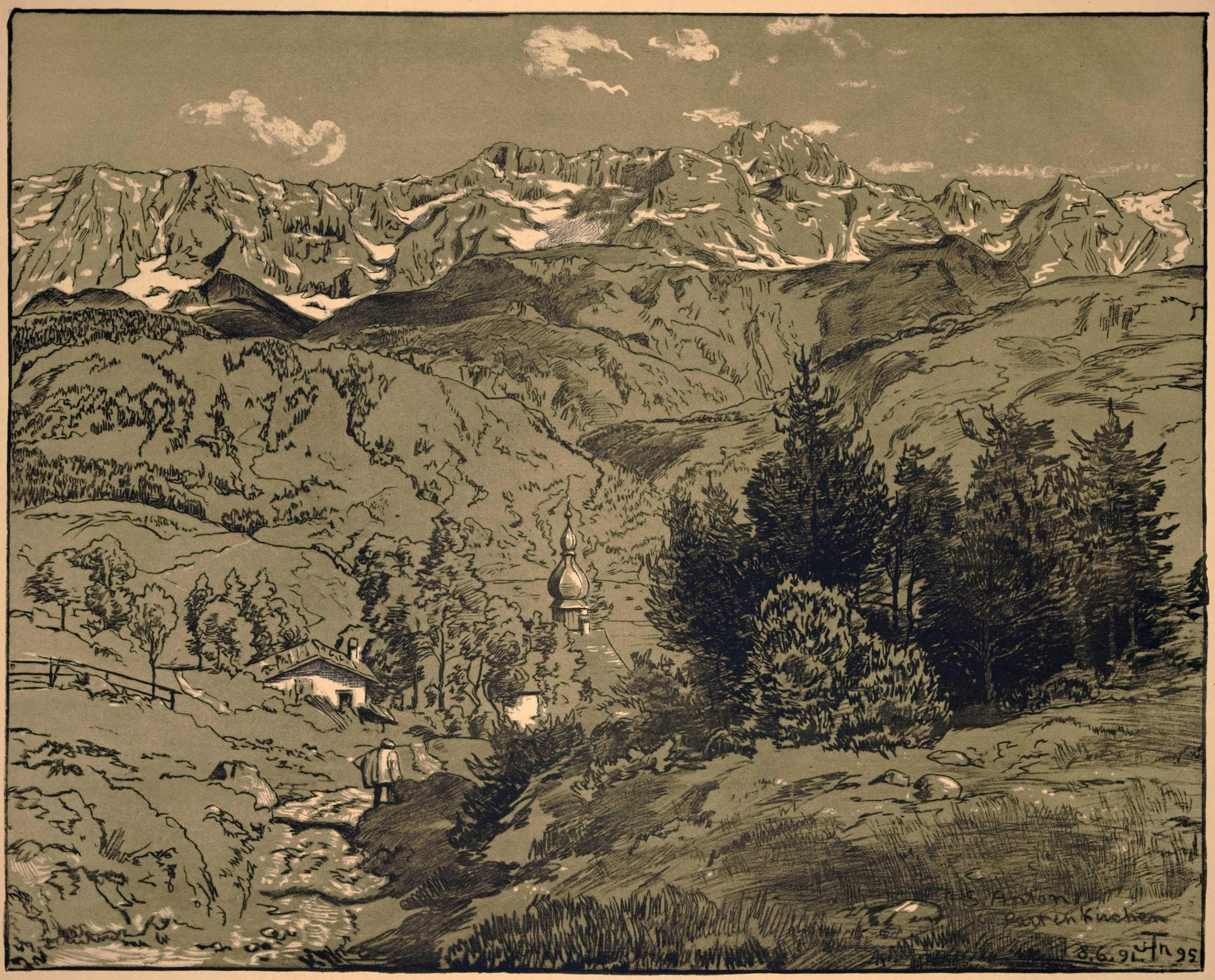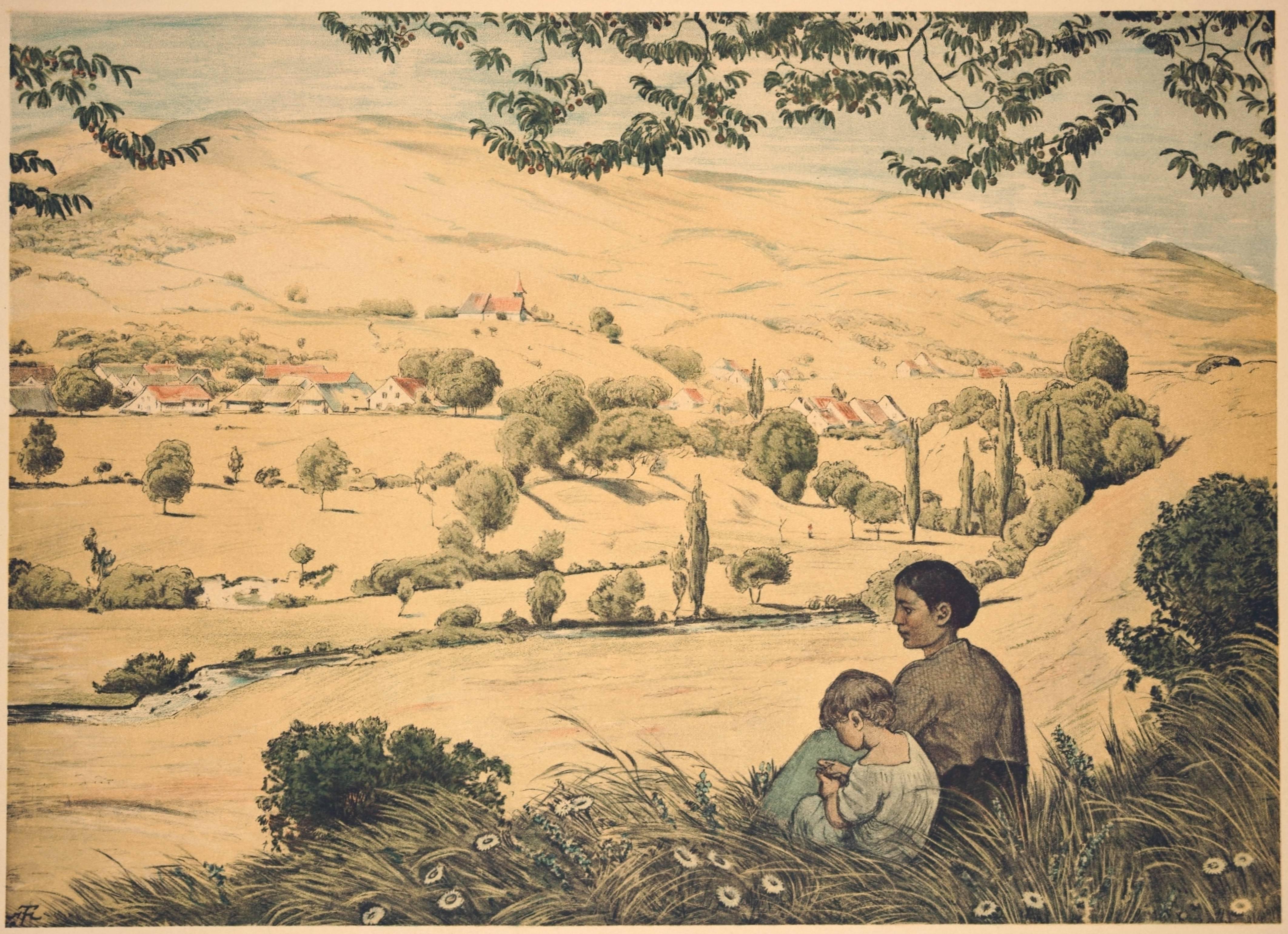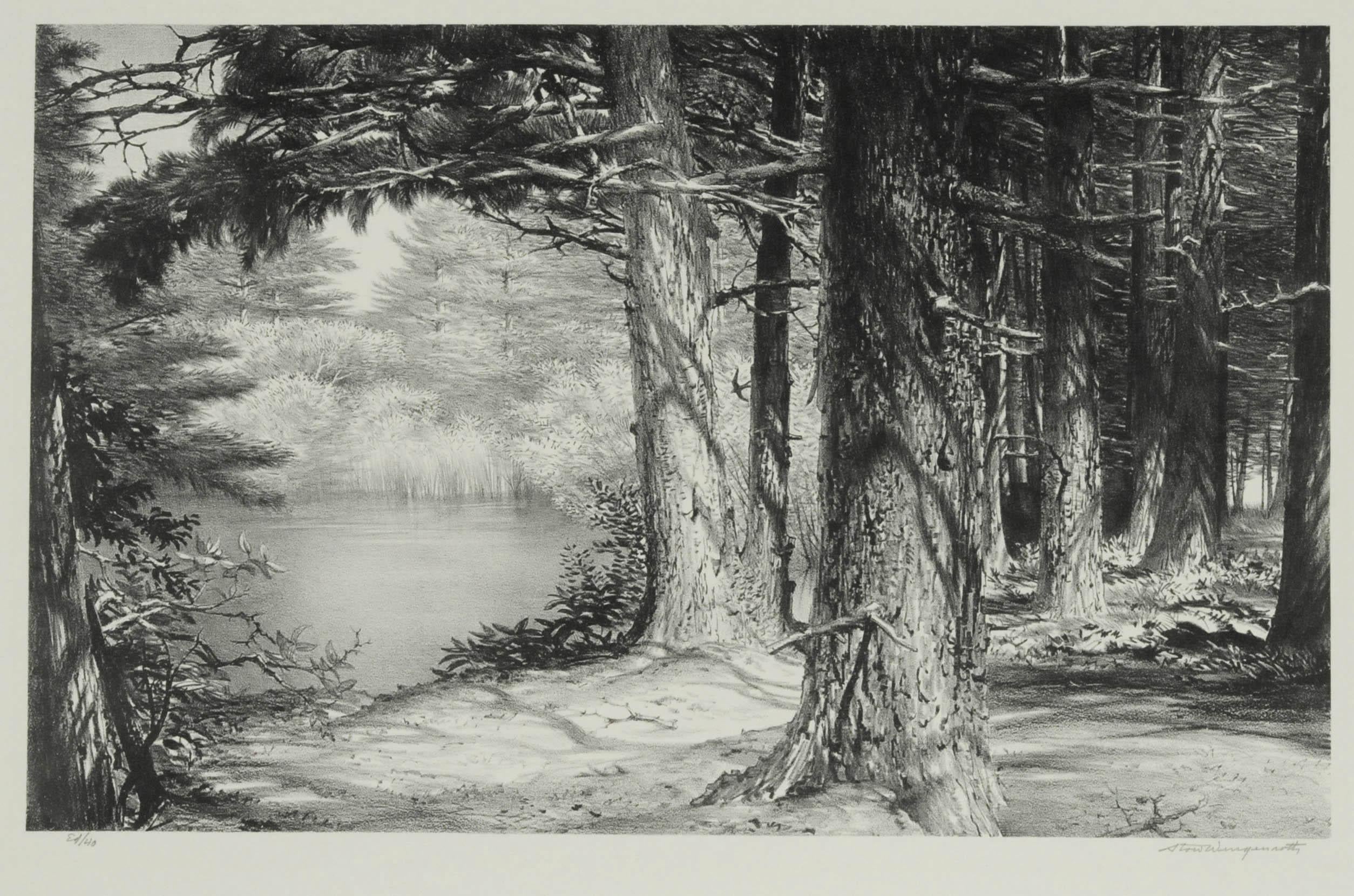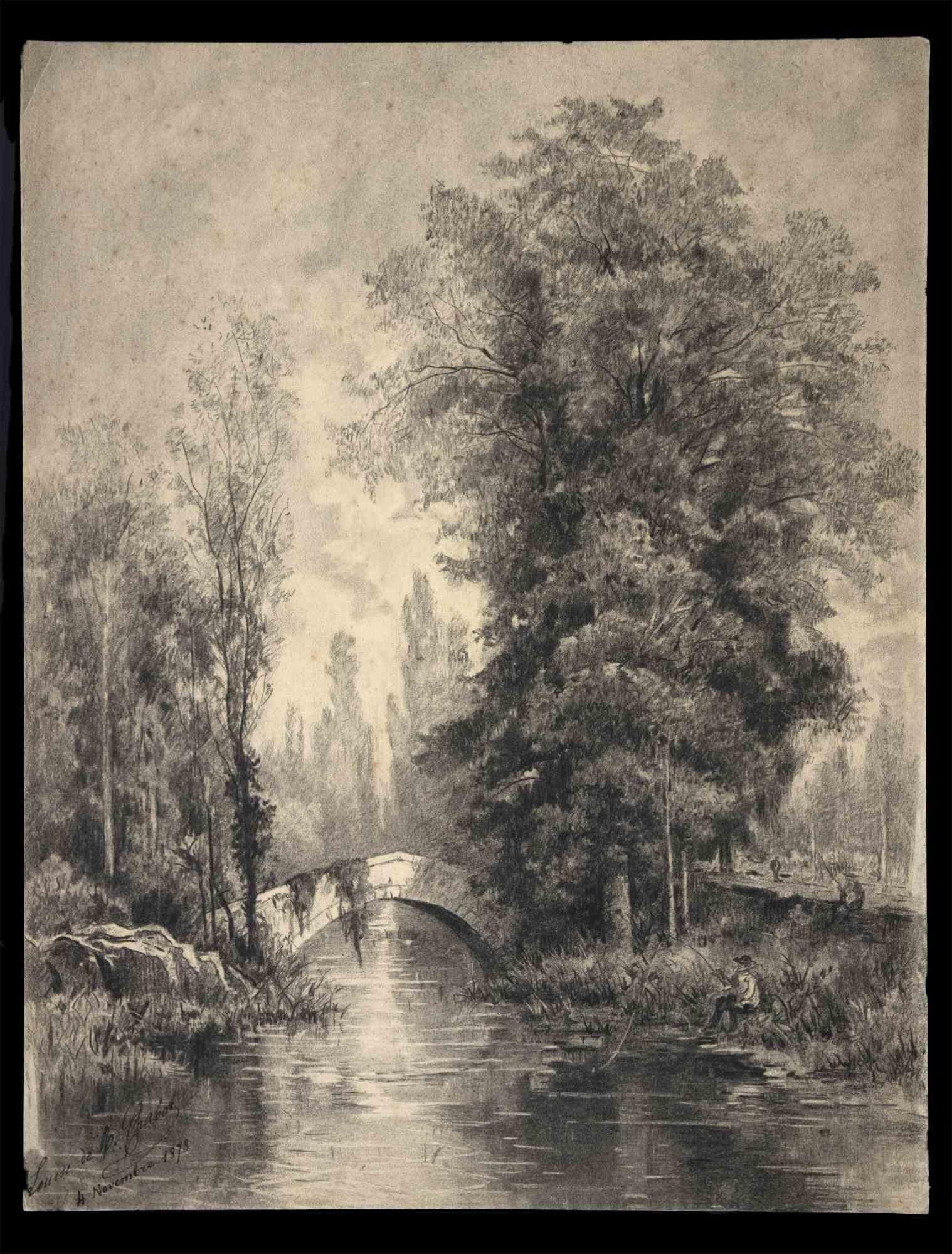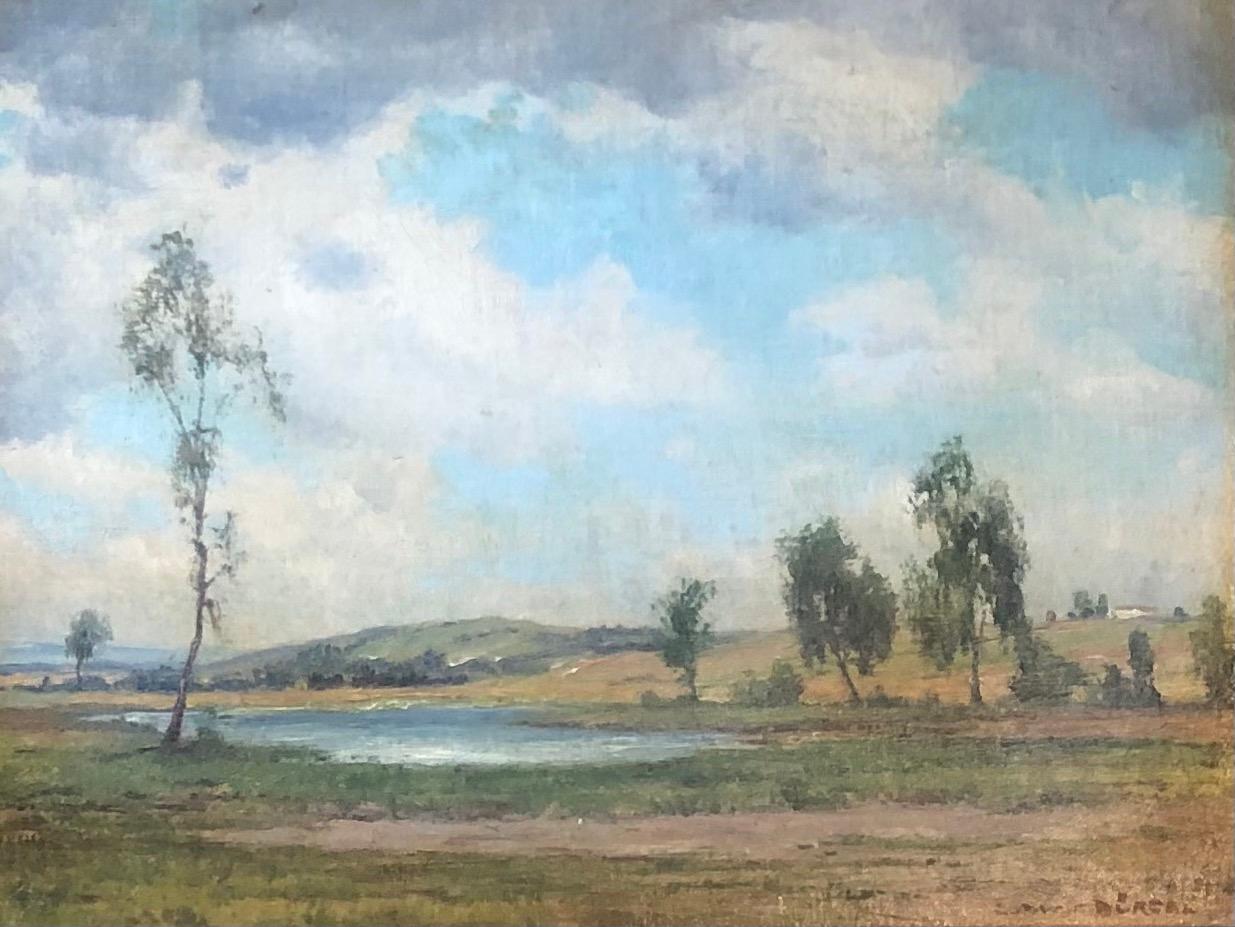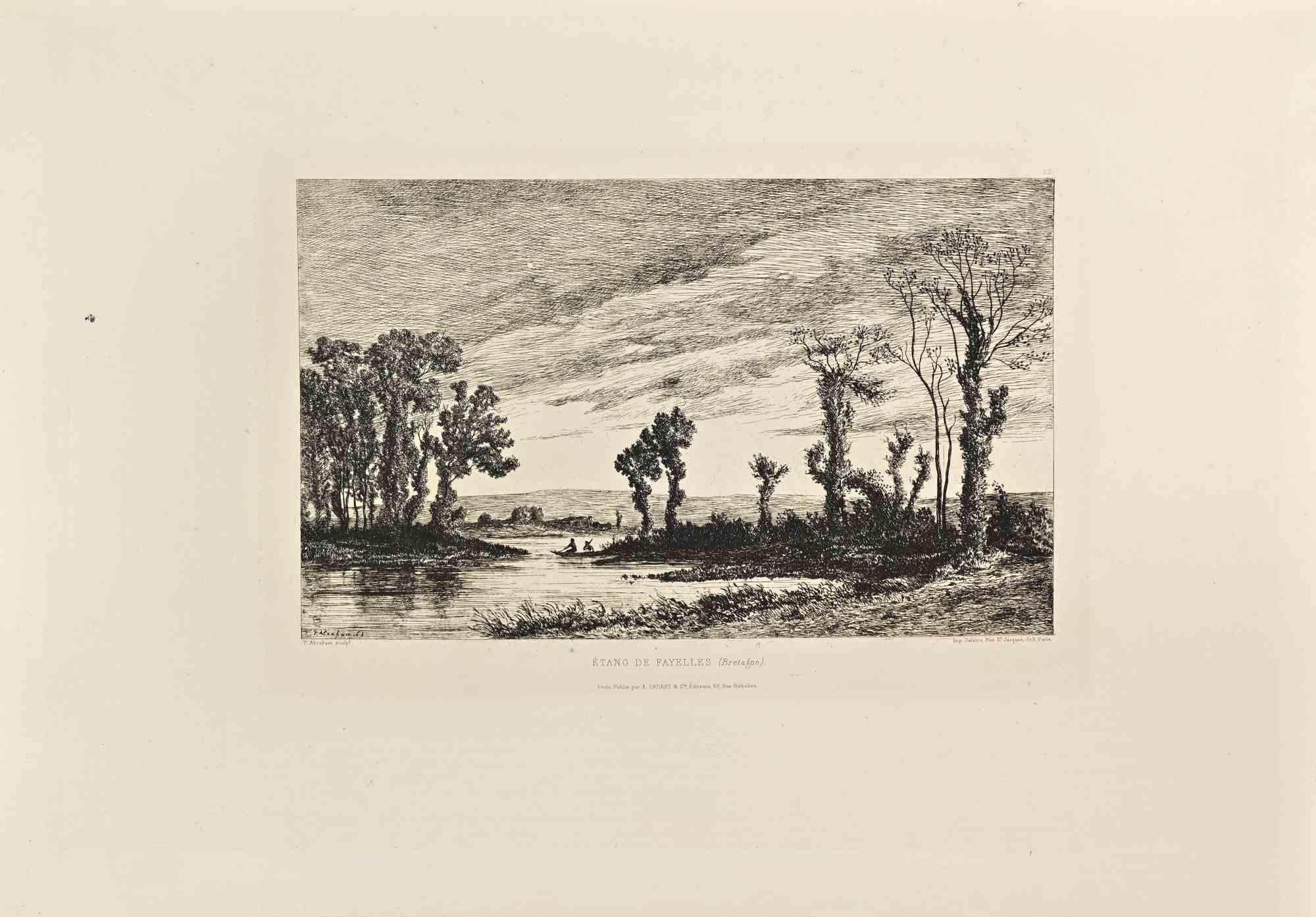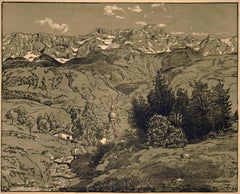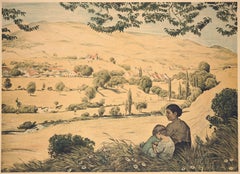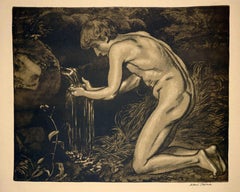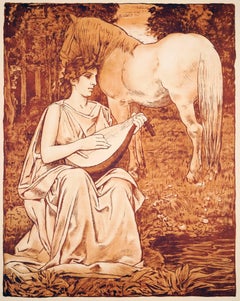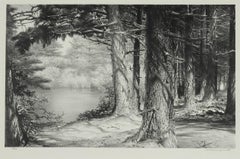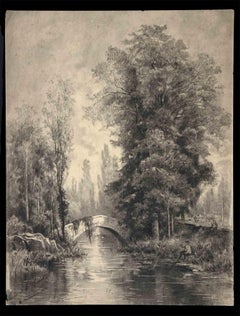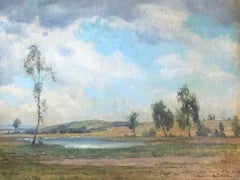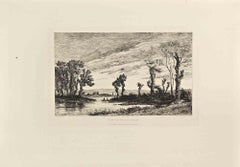Items Similar to At the pond / - The longing of the landscape -
Want more images or videos?
Request additional images or videos from the seller
1 of 8
Hans ThomaAt the pond / - The longing of the landscape -1897
1897
$179.86
$224.8320% Off
£135.67
£169.5920% Off
€152
€19020% Off
CA$252.38
CA$315.4720% Off
A$275.22
A$344.0220% Off
CHF 144.58
CHF 180.7220% Off
MX$3,298.63
MX$4,123.2820% Off
NOK 1,833.39
NOK 2,291.7420% Off
SEK 1,706.14
SEK 2,132.6820% Off
DKK 1,157.98
DKK 1,447.4720% Off
About the Item
Hans Thoma (1839 Bernau - 1924 Karlsruhe), At the pond, 1897. Algraph on strong wove paper, published by Breitkopf und Härtel in Leipzig as ‘Zeitgenössisches Kunstblatt Nr. 148’, 23.8 cm x 45.5 cm (image), 40 cm x 50 cm (sheet size), signed and dated lower right. Verso with publisher's sticker.
- Small marginal tears and a crease in the wide lower margin, otherwise in good condition
- The longing of the landscape -
Although Hans Thoma is a landscape painter, it is unusual for him to depict an entirely deserted landscape. This gives the landscape an even stronger autonomy, turning it into a pictorial narrative. A wide stream flows into the painting from the right, widening into a small lake at its center. This movement is also toward the sun's rays, which bathe the plain behind it in light. The flow of the dark water becomes a gesture of longing for light that transcends the world.
About the artist
After failing to complete his apprenticeship as a lithographer, painter and clockmaker, Hans Thoma trained as an autodidact painter. In 1859 he won a scholarship to the Karlsruhe Art School, where he became a student of Wilhelm Schirmer and Ludwig Des Coudres. After graduating in 1866, Thoma spent time in Basel and Düsseldorf. He met Otto Scholderer, with whom he traveled to Paris in 1868. There he was impressed by the art of Gustave Courbet and the Barbizon School. After his works were rejected by the Karlsruhe Kunstverein, Thoma moved to Munich in 1870, where he was close to the Leibl circle. Wilhelm Trüber worked for a time in Thoma's studio in Munich. In 1874 he made the first of a series of trips to Italy with the painter Albert Lang, where he met Hans von Marées and Adolph von Hildebrand and became friends with Arnold Böcklin, whose art made a lasting impression on Thoma. On his return to Munich, Thoma became a student of Cella Berteneder, whom he married in 1877.
Thoma traveled to England in 1879 at the invitation of art collector Charles Minoprio. Over the years, Minoprio acquired more than 60 oil paintings by Thoma and organized the first exhibition of his art abroad in Liverpool in 1884. Thoma had lived in Frankfurt since 1878. The following year, the Frankfurter Kunstverein organized the first solo exhibition of his work. After a trip to the Netherlands, Thoma moved to Kronberg im Taunus in 1899, where the Kronberg painters' colony was based. That same year he was appointed professor at the Karlsruhe Art School and director of the Karlsruhe Kunsthalle. In 1901, together with Wilhelm Süs, Hans Thoma founded the Grand Ducal Majolica Manufactory in Karlsruhe, for which he supplied designs from then on.
Thoma was now at the height of his artistic fame. The 1909 edition of Meyer's Großes Konversations-Lexikon noted that Thoma had become one of the German people's favorite painters. On the occasion of his 80th birthday in 1919, Ernst Oppler and Lovis Corinth organized a large celebration. After Thoma's death, the Berlin National Gallery dedicated a major exhibition to him in 1922, and the Basel Kunsthalle in 1924.
GERMAN VERSION
Hans Thoma (1839 Bernau - 1924 Karlsruhe), Am Weiher, 1897. Algraphie auf kräftigem Velin, bei Breitkopf und Härtel in Leipzig als ‚Zeitgenössisches Kunstblatt Nr. 148‘ erschienen, 23,8 cm x 45,5 cm (Darstellung), 40 cm x 50 cm (Blattgröße), rechts unten mit Signet und Datierung versehen. Rückseitig mit Verlagsaufkleber.
- kleine Randeinrisse und eine Knickspur im breiten unteren Rand, ansonsten in gutem Zustand
- Die Sehnsucht der Landschaft -
Obwohl Hans Thoma auch Landschaftsmaler ist, ist es dennoch ungewöhnlich, dass der eine gänzliche menschenleere Landschaft veranschaulicht. Dadurch bekommt die Landschaft eine noch stärkere Eigenständigkeit und wird selbst zur Bilderzählung. So fließt ein breiter Bach von rechts in Bild hinein und weitetet sich in der Bildmitte zu einem kleinen See. Die Bewegung ist zugleich eine Bewegung hin zu den Sonnenstahlen, die die Ebene dahinter ins Licht tauchen. Der Fluss des dunklen Wassers wird zur Sehnsuchtsgeste nach dem über die Welt hinausführenden Licht.
zum Künstler
Nachdem er Lehren als Lithograph, Anstreicher und Uhrschildmaler abgebrochen hatte, bildete sich Hans Thoma autodidaktisch als Kunstmaler. Dies brachte ihm 1859 ein Stipendium für die Kunstschule in Karlsruhe ein, wo er Schüler von Wilhelm Schirmer und Ludwig Des Coudres wurde. Nach Abschluss des Studiums, 1866, hielt sich Thoma in Basel und Düsseldorf auf. Er lernte Otto Scholderer kennen, mit dem er 1868 nach Paris reiste. Dort beeindruckten ihn die Kunst Gustave Courbets und die Schule von Barbizon. Nach der Ablehnung seiner Werke im Karlsruher Kunstverein wurde Thoma 1870 in München ansässig, wo er dem Leibl-Kreis nahestand. In München arbeitete Wilhelm Trüber zeitweise in Thomas Atelier. 1874 erfolgte zusammen mit dem Maler Albert Lang die erster einer Reihe von Italienreisen, auf der er Hans von Marées und Adolph von Hildebrand kennenlernte und mit Arnold Böcklin Freundschaft schloss, dessen Kunst Thoma nachhaltig beeindruckte. Nach seiner Rückkehr nach München wurde Cella Berteneder Thomas Schülerin, die er 1877 ehelichte.
Auf Einladung des Kunstsammlers Charles Minoprio reiste Thoma 1879 nach England. Im Laufe der Jahre erwarb Minoprio mehr als 60 Ölbilder Thomas und veranstaltete 1884 die erste Auslandsausstellung seiner Kunst in Liverpool. Ab 1878 lebte Thoma in Frankfurt. Im Folgejahr zeigte der Frankfurter Kunstverein die erste Einzelausstellung seiner Werke. Nach einer Reise in die Niederlande zog Thoma 1899 nach Kronberg im Taunus, wo die Kronberger Malerkolonie ansässig war. Im selben Jahr wurde er zum Professor der Karlsruher Kunstschule und zum Direkter der Karlsruher Kunsthalle berufen. 1901 war Hans Thoma mit Wilhelm Süs Gründer der Großherzoglichen Majolika-Manufaktur Karlsruhe, für die er fortan Entwürfe lieferte.
Thoma stand nun auf dem Höhepunkt seines künstlerischen Ruhmes. Meyers Großes Konversations-Lexikon stellt in der 1909 erschienen Auflage fest, Thoma sei zu einem Lieblingsmaler des deutschen Volkes geworden. Anlässlich des 80. Geburtstags, 1919, organisierten Ernst Oppler und Lovis Corinth eine große Feierlichkeit. Nachdem Thoma verstorben war, widmete ihm die Berliner Nationalgalerie 1922 und die Basler Kunsthalle 1924 eine große Werkschau.

About the Seller
5.0
Vetted Professional Seller
Every seller passes strict standards for authenticity and reliability
Established in 2014
1stDibs seller since 2023
22 sales on 1stDibs
- ShippingRetrieving quote...Shipping from: Berlin, Germany
- Return Policy
More From This Seller
View AllS. Anton Patenkirchen / - The Home of the Landscape -
Located in Berlin, DE
Hans Thoma (1839 Bernau - 1924 Karlsruhe), S. Anton Patenkirchen, 1895. Algraph on strong wove paper, published by Breitkopf und Härtel in Leipzig as ‘Zeitgenössisches Kunstblatt Nr....
Category
1890s Realist Figurative Prints
Materials
Paper
$179 Sale Price
20% Off
Southern German summer landscape / - The profile of the landscape -
Located in Berlin, DE
Hans Thoma (1839 Bernau - 1924 Karlsruhe), Southern German summer landscape, around 1897. Algraph on strong wove paper, published by Breitkopf und Härtel in Leipzig as ‘Zeitgenössisc...
Category
1890s Realist Figurative Prints
Materials
Paper
$179 Sale Price
20% Off
Boy at the source / - Elixir of Life -
Located in Berlin, DE
Hans Thoma (1839 Bernau - 1924 Karlsruhe), Boy at the source, 1897. Algraph on strong wove paper after a drawing from 1897, published by Breitkopf und Härtel in Leipzig as ‘Zeitgenös...
Category
1890s Realist Figurative Prints
Materials
Paper
$265 Sale Price
20% Off
Muse / - In the realm of the muses -
Located in Berlin, DE
Hans Thoma (1839 Bernau - 1924 Karlsruhe), Muse, 1893. Algraph on strong wove paper, published by Breitkopf und Härtel in Leipzig as ‘Zeitgenössisches Kunstblatt Nr. 174’, 43.5 cm x ...
Category
1890s Realist Figurative Prints
Materials
Paper
$227 Sale Price
20% Off
Late Summer River Landscape / - Realistic Impression -
By Jan Hillebrand Wijsmüller
Located in Berlin, DE
Jan Hillebrand Wijsmuller (1855 Amsterdam - 1925 ibid.), Late Summer River Landscape, oil on canvas, relined, 34 x 56 cm (inside measurement), 43 x 64 cm (frame), signed J[an] H[illebrand] Wijsmuller at lower right.
- in good condition, the frame with isolated bumped spots
- Realistic Impression -
About the artwork
The panoramic landscape format shows a river landscape, with the course of the river, which curves to the right, leading the eye into the depths of the picture and tempting it to continue the landscape in the imagination beyond the visible area. At the same time, however, the fact that the landscape is not visible through the bend in the river focuses our gaze on the entirety of the landscape depicted, without prompting us to focus on distant details. Accordingly, the brushstroke is not designed to render details with realistic precision. In the front left area of the river there is even a completely free brushwork, trained by Impressionism, which nevertheless remains committed to representational and convincingly suggests the movement of the water.
Regardless of the distance of the observer, the entire picture is painted with the same broad brushstroke, so that the landscape is given as an impression. And yet this impression is not ephemeral, as in the case of French Impressionism, to put it exaggeratedly, but reveals to us the essence of the landscape in all its richness. This is why the Dutch variant of Impressionism is always also a realism, although the pictures appear less progressive, but still contain a dimension of landscape painting that is lost with progress.
In the impression, the reality of the landscape is revealed, and this happens as we experience the landscape in the visual impression. Wijsmuller does not depict houses or people in order to allow the experience of the landscape to fully unfold. The experience is determined first and foremost by the river, which does not flow into the picture from our point of view, but towards us. Where the river begins to bend, the water is churned by a rapids. Toward us, the riverbed widens and the water comes to rest, covering the entire width of the foreground like a mirror.
The stillness of the water corresponds to the evening mood of the late summer landscape, in which the warm tones of the evening light blend with the yellow and brown tones of the plants. A gentle, almost idyllic reality, carried by the brushstroke, yet animated by a liveliness that is also made visible by the brushstroke. The broad, dynamically placed brushstrokes evoke the movement of the treetops and animate even the immobile reeds, while the trunks on the right bank, executed in virtuoso white strokes that seem like markings, make the sunlight shine. On the other bank, a carpet of light also spreads out, its energetic effect again expressed in the brushstroke. The dynamic of the landscape is further enhanced by the complementary color contrasts between the greens, yellows, and browns on the one hand and the blue of the all-encompassing sky on the other. A contrast that is intensified by the reflection in the water.
The evening coming to rest of the landscape is thus at the same time an all-encompassing contrasting and yet in itself harmonious movement. This reality becomes accessible to us as an experience in the impression of the landscape.
About the artist
Jan Hillebrand Wijsmuller entered the Royal Academy of Arts in Amsterdam in 1876 and studied under the innovative Professor August Allebé, who was famous for the Amsterdam Impressionism, also known as the Allebé School.
In 1877, Wijsmuller transferred to the Hague Academy of Art, and thus to the Hague School, and then completed his studies at the Brussels Academy of Art. Returning to the Netherlands, Wijsmuller opened his own studio in Amsterdam.
In 1883 he won the prestigious Young Artist Award, donated by Willink van Collen, which made Wijsmuller a well-known and sought-after artist.
Wijsmuller was a member of the Societät Arti et Amicitiae Amsterdam and the Pulchri Studio in The Hague.
Wijsmuller belongs to the second generation of the Hague School. While Vincent van Gogh described the protagonists of the first generation to his brother Theo as "the great gray people," the second generation, and Wijsmuller in particular, used a much more colorful palette. His oeuvre makes him a major player in Dutch Impressionism...
Category
1890s Impressionist Landscape Paintings
Materials
Canvas
$3,597 Sale Price
20% Off
Woodland / - The Inner Drama of the Landscape -
Located in Berlin, DE
Eduard Peithner von Lichtenfels (1833 Vienna - 1913 Berlin), Woodland, 1884. Watercolor and pen and ink on drawing paper, 30.4 cm x 22.5 cm, signed, dated and inscribed by the artist...
Category
1880s Landscape Drawings and Watercolors
Materials
Paper
$549 Sale Price
20% Off
You May Also Like
Hidden Pond
By Stow Wengenroth
Located in Fairlawn, OH
Hidden Pond
Lithograph, 1958
Signed in pencil lower right of image
Annotated: Ed/40 in pencil by the artist lower left
Edition: 40
Provenance:
Baldwin-Wallace College, Berea, OH (acc...
Category
1950s American Realist Landscape Prints
Materials
Lithograph
The French Landscape - Original Lithograph by Louise de Rohan-Chabot - 1878
Located in Roma, IT
The french Landscape is an original Lithograph realized by Louise de Rohan-Chabot in 1878.
Good conditions except for some foxings.
Signed and dated lower left, 1878.
The artwork ...
Category
1870s Modern Figurative Prints
Materials
Lithograph
the pond
Located in Genève, GE
Work on wood
Golden wooden frame
41 x 51 x 4 cm
Category
Mid-20th Century Landscape Paintings
Materials
Oil
$1,597
Etang de Fayelles - Etching by Tancrède Abraham - 1860s
Located in Roma, IT
Etang de Fayelles is a black and White etching realized by Tancrède Abraham in the 1860s.
Titled in the lower
Image Size: 21x32
Very good impression.
Realized for the "Société d...
Category
1860s Modern Figurative Prints
Materials
Etching
The Landscape - Drawing - Late 19th century
Located in Roma, IT
The Landscape is a drawing realized by an anonymous artist in the late 19th century.
Pastel on paper.
Good conditions.
Poetic and beautiful drawing.
Category
19th Century Modern Figurative Drawings and Watercolors
Materials
Pastel
Paysage - Etching by Léo Drouyn - 1870s
Located in Roma, IT
Paysage is an artwork realized by Léo Drouyn in the 1870s.
Etching.
Good conditions.
Realized for the "Société des Aquafortistes. Born on the initiative of the publisher Alfred C...
Category
1870s Modern Figurative Prints
Materials
Etching
More Ways To Browse
Antique Kunst
Antique Invitations
Antique Stickers
Antique Nun
Lang Antique
Wesselmann Foot
Western Airlines Poster
Whistler Original Print
William Greengrass
Winslow Homer Etchings
Zodiac Sign Hebrew
1790 Lithograph
1800s Vintage Dresses
1940s Vintage Pin Up Art
1972 Pontiac
1980s Vintage Museum Poster
Alec Monopoly Signed
Alex Katz Sarah
